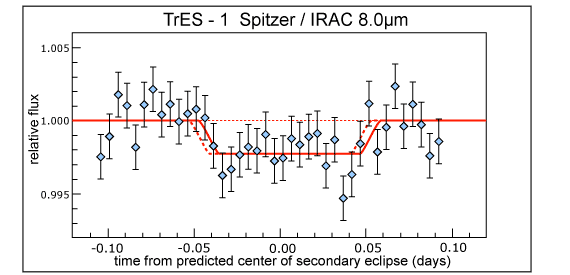First direction detection of light from extrasolar planets
The TrES group, led by David Charbonneau of the Harvard-Smithsonian Center for Astrophysics, directly detected (original webpage) light from TrES-1, an extrasolar gas giant that we previously discovered from the transit of the planet in front of its star. We used the Infrared Array Camera (IRAC) aboard NASA’s Spitzer Space Telescope to observe TrES-1 in the infrared region of the spectrum. We chose the infrared rather than the visible region because the planet is brighter relative to the star at these wavelengths, making it easier to see the planet’s faint emission.

We timed our observations so as to observe the secondary eclipse, when the planet passes behind the star. We detected a slight reduction in light coming from the TrES-1 system at the time of secondary eclipse, shown in the above light curve. We were able to use these observations to determine that the temperature of the planet is about 1100 Kelvin and that the planet reflects only 31% of the light it receives from the star. As a hot Jupiter TrES-1 should have a circular orbit, unless a companion planet (as yet undetected) interacts with TrES-1 to increase the eccentricity of the gas giant. If TrES-1 has a non-circular orbit, the time at which the secondary eclipse would occur would not be exactly half an orbital period after the primary eclipse. We determined the time of the secondary eclipse and have deduced that TrES-1 has a negligible orbital eccentricity.

Leave a comment